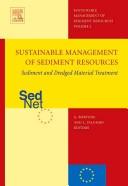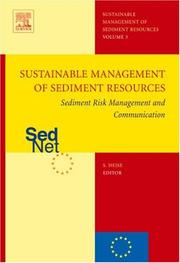| Listing 1 - 4 of 4 |
Sort by
|

ISBN: 9780444519634 9780080466682 0080466680 0444519637 Year: 2007 Publisher: Amsterdam Elsevier
Abstract | Keywords | Export | Availability | Bookmark
 Loading...
Loading...Choose an application
- Reference Manager
- EndNote
- RefWorks (Direct export to RefWorks)
Sediment and Dredged Material Treatment forms the second volume in the SEDNET mini-series, Sustainable Management of Sediment Resources. The volume asks "How can you achieve sustainable sediment treatment?". In fact, before this question can be answered, many steps have to be considered beforehand. This book tackles the questions and issues which arise when looking at the various steps involved. This volume is applicable to a wide audience, from students at the graduate level, to experienced researchers and laboratory personnel in academia, industry and government. * Gives a broad overview on sediment treatment with a European perspective * Suitable for those new to sediment treatment as well as specialists in the field * Provides an overview on the costs involved in sediment treatment.

ISBN: 9780444519634 9780080466682 0080466680 0444519637 9786610729180 128072918X Year: 2007 Publisher: Amsterdam Boston Elsevier
Abstract | Keywords | Export | Availability | Bookmark
 Loading...
Loading...Choose an application
- Reference Manager
- EndNote
- RefWorks (Direct export to RefWorks)
Sediment and Dredged Material Treatment forms the second volume in the SEDNET mini-series, Sustainable Management of Sediment Resources. The volume asks ""How can you achieve sustainable sediment treatment?"". In fact, before this question can be answered, many steps have to be considered beforehand. This book tackles the questions and issues which arise when looking at the various steps involved.This volume is applicable to a wide audience, from students at the graduate level, to experienced researchers and laboratory personnel in academia, industry and government.This v
Environmental protection. Environmental technology --- Dredging spoil --- Soil remediation. --- Cleanup of contaminated soil --- Remediation of contaminated soil --- Soil cleanup --- Soil contamination remediation --- Soil protection --- Soil pollution --- Dredge spoil --- Dredged material --- Material, Dredged --- Spoil, Dredging --- Dredging --- Waste products --- Spoil banks --- Environmental aspects.


ISBN: 1280751797 9786610751792 0080469310 0444519653 9780444519658 9780080469317 Year: 2007 Publisher: Amsterdam ; Boston : Elsevier,
Abstract | Keywords | Export | Availability | Bookmark
 Loading...
Loading...Choose an application
- Reference Manager
- EndNote
- RefWorks (Direct export to RefWorks)
In dynamic river systems, effective and sustainable risk management of sediments, contaminants and their sources must be carried out on a river basin scale. A diversity of interests and risk perceptions, whether environmental, economical, or personal, as well as the broad variety of uses and functions of river systems can lead to conflicts and disagreements about how and where river systems should be managed. This requires a transparent methodology to assess environmental risks in the river basin, followed by a prioritisation of those sites where measures would yield the highest positive effec
Dredging spoil --- Sediments (Geology) --- Soil remediation --- Contaminated sediments --- Environmental aspects --- Analysis --- Polluted sediments --- Pollution --- Geology --- Physical geography --- Sedimentary rocks --- Sedimentation and deposition --- Marine sediments --- Slackwater deposits --- Dredge spoil --- Dredged material --- Material, Dredged --- Spoil, Dredging --- Dredging --- Waste products --- Spoil banks


ISBN: 9780080466675 0080466672 1280729171 9781280729171 9780444519610 0444519610 9780080466682 0080466680 9780080469317 0080469310 9786611055141 128105514X 0080553265 9780444519627 0444519629 9786610729173 9780080553269 Year: 2008 Publisher: Amsterdam Boston Elsevier
Abstract | Keywords | Export | Availability | Bookmark
 Loading...
Loading...Choose an application
- Reference Manager
- EndNote
- RefWorks (Direct export to RefWorks)
Sediments are a natural part of aquatic systems and they are essential for the hydrological, geomorphological and ecological functioning of those systems. For society they are important and represent an important resource. However, due to the ever increasing use of river catchments, sediments need to be managed in a balanced and sustainable way. Sediment Management at the River Basin Scale reviews some of the key requirements and challenges facing scientists, river basin managers, and policy makers for sustainable sediment management at the river basin scale, and puts forward important
Dredging spoil --- Sediments (Geology) --- Soil remediation --- Contaminated sediments --- Polluted sediments --- Pollution --- Geology --- Physical geography --- Sedimentary rocks --- Sedimentation and deposition --- Marine sediments --- Slackwater deposits --- Dredge spoil --- Dredged material --- Material, Dredged --- Spoil, Dredging --- Dredging --- Waste products --- Spoil banks --- Environmental aspects --- Analysis
| Listing 1 - 4 of 4 |
Sort by
|

 Search
Search Feedback
Feedback About UniCat
About UniCat  Help
Help News
News